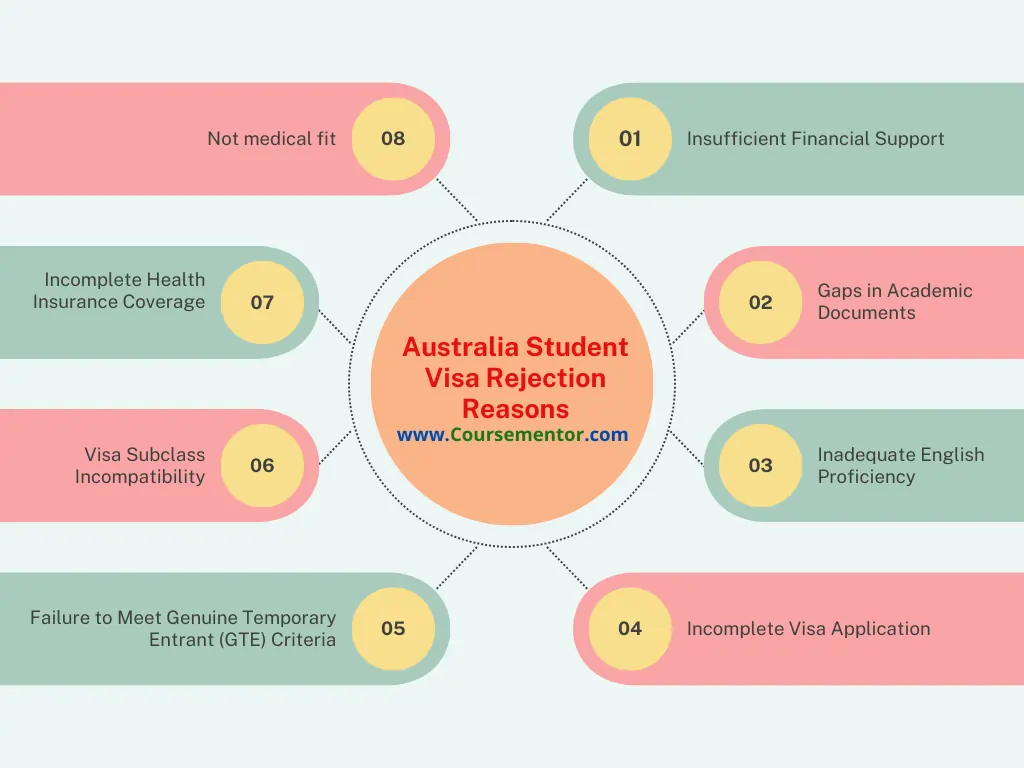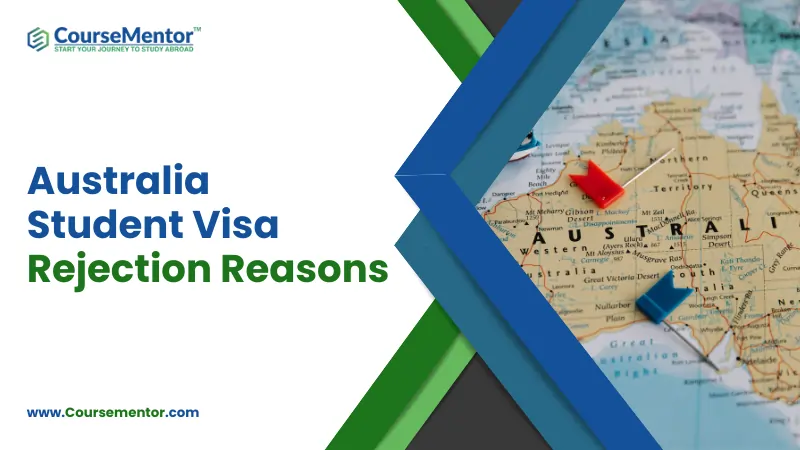Australia is renowned for its high-quality education system among international students. Making it a sought-after destination for students who wish to study in Australia. However, obtaining a student visa to study in Australia can be a complex process, and many applicants face rejection.
So, to help you navigate the application process successfully. It’s essential to understand the common reasons for student visa rejections in Australia. In this blog, we’ll discuss the Australia student visa rejection, and the ways to avoid student visa rejection. Moving further, we will also give insights on what to consider before reapplying for Australia Student Visa.
Types of Australia Student Visa
Before discussing the Australia Student Visa Rejection Reasons. Firstly, let’s discuss the types of Australia Student Visas:
Subclass 500: Higher Education Sector Visa
This visa is for international students who plan to study at a higher education level, such as a university or college. In addition, Subclass 500 allows you to undertake a bachelor’s, master’s, or doctoral degree.
Subclass 500: Non-Award Sector Visa
The Non-Award Sector Visa is for international students who wish to undertake non-award courses or other study programs that do not lead to a formal degree or diploma. It covers short courses, bridging programs, and other educational options.
Subclass 485: Temporary Graduate Visa
This visa allows international students who have completed a degree or diploma in Australia to work, study, or live in Australia temporarily after their studies. Moreover, there are two streams for this visa: the Graduate Work stream and the Post-Study Work stream, each with specific eligibility criteria.
It’s important to choose the correct student visa subclass that aligns with your intended course of study, educational level, and personal circumstances.
Also Read: How much Student Visa Australia Cost to Indian Students?
Australia Student Visa Rejection Reasons
The various Australia student visa rejection reasons due to which the student visas get rejected are as follows:

1. Insufficient Financial Support
Among the australia student visa rejection reasons, the first is having insufficient financial support. Because the primary requirement for obtaining an Australian student visa is demonstrating adequate financial support to cover tuition fees, living expenses, and health insurance. The Australian government wants to ensure that you won’t become a burden on their welfare system.
Therefore, if your financial documents are incomplete, inaccurate, or don’t show sufficient funds, your visa application may be rejected. Make sure to provide detailed and accurate financial records, such as bank statements or sponsor letters, to meet this requirement.
2. Gaps in Academic Documents
Inaccurate or incomplete academic documents are among other australia student visa rejection reasons. Ensure that all your academic transcripts, diplomas, and certificates are genuine and match the information provided in your application. The Australian Department of Home Affairs may verify your qualifications so that any discrepancies can lead to visa denial.
3. Lack of Genuine Temporary Entrant (GTE) Statement
A GTE statement is a mandatory part of the student visa application process. It is your opportunity to convince the authorities that you genuinely intend to study in Australia and will return to your home country after your studies.
So, if your GTE statement lacks clarity, sincerity, or convincing evidence, your visa application could be denied. To avoid this, take time to craft a well-written GTE statement that aligns with your academic and career goals.
Also Read: Best Courses to Study in Australia for International Students
4. Inadequate English Proficiency
For non-English-speaking applicants, providing proof of English proficiency through exams like IELTS, TOEFL, or PTE is essential. Failing to meet the required language proficiency score can be a significant australia student visa rejection reasons. Be sure to take these tests seriously and aim to achieve the necessary score well before submitting your visa application.
5. Health Issues
Applicants must meet health and character requirements to obtain an Australian student visa. Failing to undergo the required medical examinations or having a criminal record can lead to australia student visa rejection reasons.
So, it’s crucial to address any health or character concerns and provide the necessary documentation, such as police clearance certificates, as part of your application.
6. Incomplete Visa Application
An incomplete visa application is a surefire way to get rejected. Ensure you complete all required forms, attach all necessary documents, and pay the visa application fee on time.
It’s a good practice to double-check your application before submission and seek professional guidance if needed. Because having incomplete visa applications is also among australia student visa rejection reasons.
7. Failure to Meet Genuine Temporary Entrant (GTE) Criteria
The GTE criteria involve assessing your intentions and commitment to studying in Australia. The authorities will evaluate factors such as your choice of course, your previous academic history, and your immigration history.
If your circumstances or reasons for studying in Australia appear inconsistent or lack a genuine educational purpose. Then, it also becomes an australia student visa rejection reasons.
8. Visa Subclass Incompatibility
Among the australia student visa rejection reasons, the other reason is having visa subclass incompatibility. So, to avoid this visa rejection reason, make sure you select the appropriate visa subclass that corresponds to your intended course and situation. Different visa subclasses have specific requirements and entitlements, so understanding them is crucial.
9. Incomplete Health Insurance Coverage
Health insurance is mandatory for all international students in Australia. If your Overseas Student Health Cover (OSHC) is insufficient or has coverage gaps, your application might be rejected. Make sure your OSHC is valid for the entire duration of your study program and complies with the Australian government’s requirements.
Also Read: Benefits of Studying in Australia for Indian Students
What to Consider Before Reapplying Australia Student Visa?
Now, you are equipped with all the information on australia student visa rejection reasons. Moving further, let’s discuss the things that an international student should consider before reapplying for an Australia Student Visa.
Here are some key things to consider before reapplying for an Australia student visa:

Conclusion
Obtaining an Australian student visa is a pivotal step toward pursuing your educational dreams in Australia. To avoid rejection, it’s essential to pay attention to these common reasons for visa rejections and prepare your application meticulously.
Seek professional advice if you’re unsure about any aspect of the application process, and always be honest and transparent in your documentation and statements. By doing so, you can increase your chances of obtaining an Australian student visa and experiencing the world-class education that Australia has to offer.
In this blog, we have discussed the australia student visa rejection reasons and things to consider before reapplying Australia Student Visa. If you still have any doubts, you can consult our experts and get free guidance for studying abroad career guidance. Remember to revisit to learn more information on studying abroad.
Frequently Asked Questions (FAQs)
Why does an Australian student Visa get rejected?
Australian student visas can be rejected for reasons such as insufficient financial support, failure to meet health requirements, incomplete or inaccurate documentation, or concerns about the genuine intent to study in Australia.
What are the reasons for Australia Student Visa Rejection?
Australian student Visa applications can be rejected due to insufficient funds, gaps in academic documents, or failure to meet health and character requirements.
Can I apply for an Australia Student Visa after Refusal?
Yes, you can apply for an Australia Student Visa after a refusal. However, it’s essential to address the reasons for the previous refusal and provide additional supporting documents or information to strengthen your new application.


